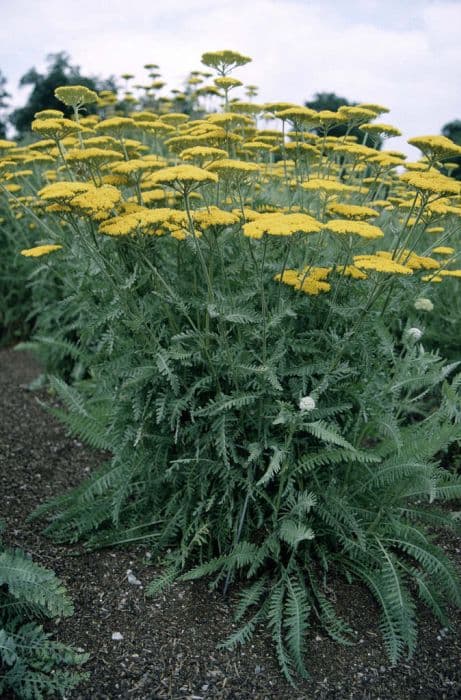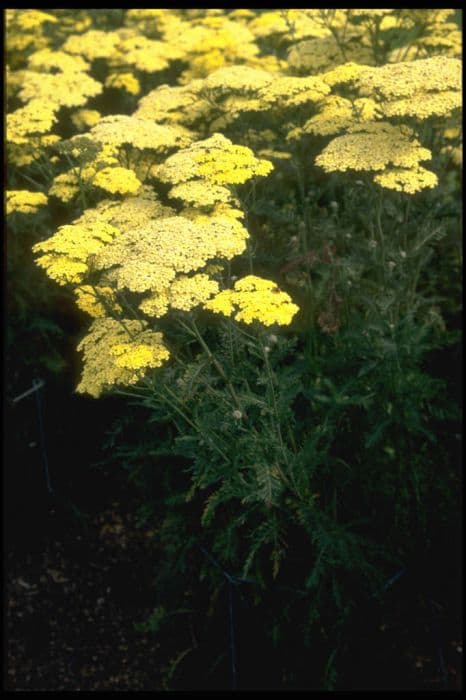Italian Aster Aster amellus 'Rudolph Goethe'
ABOUT
The Aster amellus 'Rudolph Goethe', commonly known as the Italian Aster, is a flowering perennial that showcases an array of daisy-like blooms. These flowers feature a vivid purple hue with yellow centers, exuding a charming and striking contrast that can catch any onlooker's gaze. Each individual petal is slender and elongated, radiating outward from the central disc, which is made up of tiny, tubular florets that hold pollen. The vivid purple petals are typically arranged in a singular flat-topped layer, giving this Italian Aster a classic and neat composite flower look. This plant possesses a bushy clump of bright green foliage. The leaves are narrow and lance-shaped, sometimes with slightly serrated edges that add texture to its overall appearance. These leaves are compactly arrayed along the plant’s stems, providing a lush backdrop for the vibrant floral display above. The foliage tends to be dense, offering a nice contrast in color and form to the blossoming flowers. Overall, the Italian Aster 'Rudolph Goethe' brings a splash of color and an elegant form to any garden, standing out with its striking purple flowers and sunny yellow centers, all the while supported by a robust and verdant foliage base.
About this plant
 Names
NamesFamily
Asteraceae
Synonyms
Italian Aster, European Michaelmas Daisy
Common names
Aster amellus 'Rudolph Goethe'.
 Toxicity
ToxicityTo humans
European Michaelmas Daisy, generally known for its ornamental value, does not pose a significant threat in terms of toxicity to humans. There are no well-documented cases or clear toxic effects following the ingestion of the European Michaelmas Daisy for humans. However, as with any plant material that is not typically consumed as food, individuals may experience adverse reactions if ingested due to plant compounds, natural irritants, or individual allergies. Reactions could range from gastrointestinal discomfort, such as nausea or diarrhea, to allergic reactions in people who are sensitive to the Asteraceae family. It is recommended to keep ornamental plants out of reach of young children who may accidentally ingest plant parts.
To pets
European Michaelmas Daisy is not commonly recognized as a poisonous plant to pets. While it is always better to prevent pets from eating non-food plants due to the risk of gastrointestinal upset or an unexpected allergic reaction, the European Michaelmas Daisy does not usually cause serious toxicity. If ingested, a pet may experience mild digestive discomfort, such as vomiting or diarrhea. More significant reactions could potentially occur in pets with specific sensitivities or allergies. If you notice your pet has consumed this plant and is displaying symptoms, it is best to consult with a veterinarian.
 Characteristics
CharacteristicsLife cycle
Perennials
Foliage type
Deciduous
Color of leaves
Green
Flower color
Varies
Height
1-2 feet (30-60 cm)
Spread
1-2 feet (30-60 cm)
Plant type
Herb
Hardiness zones
5
Native area
Europe
Benefits
 General Benefits
General Benefits- Ornamental Value: The Aster amellus 'Rudolph Goethe', commonly known as Italian Aster, adds aesthetic appeal to gardens with its vibrant purple flowers and attractive form.
- Attracts Pollinators: Italian Aster is effective in attracting bees, butterflies, and other pollinators, supporting the ecosystem and promoting biodiversity.
- Low Maintenance: Italian Aster is known for being low maintenance, requiring minimal care once established, making it a convenient choice for gardeners of all levels.
- Drought Resistance: This plant is relatively drought-tolerant, making it suitable for gardens in drier climates or for water-wise landscaping efforts.
- Long Blooming Period: The Italian Aster typically has a long flowering season, providing color and interest in the garden from late summer to autumn.
- Cold Hardy: It is capable of withstanding colder temperatures, which makes it a suitable perennial for many temperate climates.
- Soil Adaptability: Italian Aster can grow in a range of soil types, from sandy to loamy, as long as the soil is well-drained.
- Versatile Landscaping: These plants can be used in various landscaping designs including borders, rock gardens, and as cut flowers for indoor arrangements.
- Wildlife Support: By offering nectar and pollen, Italian Aster plays a role in sustaining wildlife, including beneficial insects and birds.
 Medical Properties
Medical PropertiesThis plant is not used for medical purposes.
 Air-purifying Qualities
Air-purifying QualitiesThis plant is not specifically known for air purifying qualities.
 Other Uses
Other Uses- Aster amellus 'Rudolph Goethe' can be utilized as a natural dye for fabrics, giving them a gentle lavender to violet hue depending upon the mordant used.
- The flowers of Italian aster can serve as a motif in artwork and photography due to their vibrant color and appealing symmetry.
- The petals of Italian aster can be used in the making of potpourri for a subtle, sweet fragrance in the home.
- Bees and other pollinators are attracted to Italian aster, making it a beneficial plant for supporting local ecosystems and pollinator-friendly gardens.
- Italian aster can be utilized in educational settings such as schools or botanical gardens to teach about plant lifecycles and the importance of biodiversity.
- The seeds of the Italian aster can be used in crafts, especially for creating intricate and natural jewelry pieces like necklaces or earrings.
- Dried Italian aster stems can be woven into baskets or decorative items, adding texture and color to handmade crafts.
- Italian aster can be used in companion planting strategies to boost the growth and health of certain vegetables in gardens by attracting the right kind of insects.
- The blooms of Italian aster provide a striking natural material for the art of flower pressing, used in scrapbooking or card making.
- Italian aster can be employed in landscape design to control soil erosion due to its root structure that helps hold soil in place.
Interesting Facts
 Feng Shui
Feng ShuiThe Italian aster is not used in Feng Shui practice.
 Zodiac Sign Compitability
Zodiac Sign CompitabilityThe Italian aster is not used in astrology practice.
 Plant Symbolism
Plant Symbolism- Patience - The aster is often associated with the virtue of patience, possibly stemming from its late blooming cycle, often waiting until late summer or autumn to flower.
- Love - In Victorian floriography, the aster was a symbol of love and daintiness.
- Wisdom - The name "Aster" is derived from the Ancient Greek word meaning "star," which can connote celestial wisdom.
- Elegance - Asters, with their star-like flowers, are seen as representing refinement and an appreciation for the finer things.
- Remembrance - Asters have often been used in arrangements and symbolism around honoring and remembering the past.
- Faith - Many cultures see the aster as a symbol of faith, perhaps related to its star-shaped flower and heavenly associations.
- Valor - The aster's hardy nature can also symbolize courage and strength in the face of adversity.
 Water
WaterFor Italian Aster, it is important to water regularly to keep the soil consistently moist but not waterlogged. Water deeply once every week, providing about 1 gallon of water per plant, to encourage a strong root system. In periods of drought or extreme heat, increase the frequency to twice a week. Reduce watering during the fall as the plant prepares for dormancy. Always check the top inch of soil for dryness before watering to avoid overwatering.
 Light
LightItalian Aster thrives best in full sunlight, with at least 6 to 8 hours of direct sun exposure daily. The ideal spot would be in an open area with ample morning light and some protection from the intense late afternoon sun, which might be especially important in hotter climates.
 Temperature
TemperatureItalian Asters prefer moderate temperatures and can handle a range from about 40 to 80 degrees Fahrenheit. While they can survive light frosts, prolonged exposure below freezing may damage the plant. They grow optimally when the temperature is between 60 and 70 degrees Fahrenheit.
 Pruning
PruningPruning Italian Aster is vital for maintaining plant health and promoting abundant blooms. Deadhead spent flowers regularly to encourage new blooms. After the first frost, cut back the entire plant to a few inches above ground to prepare for winter. The best time for a major prune is late fall or early spring.
 Cleaning
CleaningAs needed
 Soil
SoilItalian Aster prefers well-drained soil rich in organic matter with a pH between 5.8 and 6.5. A mix of garden soil, compost, and sand or perlite should provide the right conditions for healthy growth. Good drainage is crucial to prevent root rot.
 Repotting
RepottingItalian Aster typically doesn't require frequent repotting and can be done every 2-3 years. Repotting should occur in the spring, just as the plant resumes active growth or when it has outgrown its current container.
 Humidity & Misting
Humidity & MistingItalian Aster thrives in average humidity conditions found outdoors. As long as the soil moisture is maintained at a healthy level, the ambient humidity doesn't have a significant impact on the plant.
 Suitable locations
Suitable locationsIndoor
Place in a bright spot and water moderately.
Outdoor
Full sun, well-drained soil, moderate watering.
Hardiness zone
4-8 USDA
 Life cycle
Life cycleAster amellus 'Rudolph Goethe', commonly known as Italian Aster, begins its life cycle when its seeds germinate in the spring, requiring well-drained soil and full sun to partial shade. The seedlings establish themselves and grow into rosettes of leaves at ground level. As the plant matures, usually within the second year, it develops stems and branches, upon which the distinctive purple flowers bloom in late summer to autumn. After flowering, the plant sets seed, which is dispersed by wind, allowing for the potential germination of new plants the following spring. In winter, the above-ground parts of the Italian Aster die back, but the plant survives underground through its perennial root system, ready to regrow in the spring. This cycle repeats annually, with the plant expanding in size and the number of flowers increasing each year.
 Propogation
PropogationPropogation time
Spring to Summer
Propogation: Aster amellus 'Rudolph Goethe', commonly known as the Italian Aster, is often propagated through division, which is the most popular method for multiplying these plants. The ideal time for dividing Italian Asters is in the spring, just as the new growth begins to emerge. To propagate by division, carefully lift the plant from the ground using a garden fork, attempting to keep the root ball intact. Gently tease apart the clumps into smaller sections, making sure that each new piece has a portion of the root system attached. These sections can then be immediately replanted in well-prepared soil, spaced around 12 to 15 inches (30 to 38 centimeters) apart to allow for adequate growth and air circulation. It's important to water the newly planted divisions thoroughly to help establish them in their new locations. This method of vegetative propagation not only creates new plants but can also rejuvenate older clumps that may have become woody or less floriferous over time.









